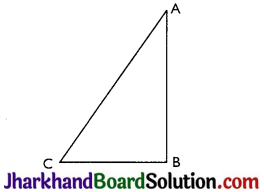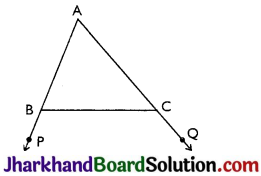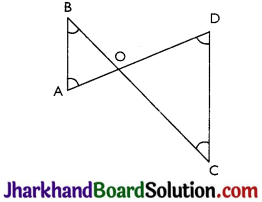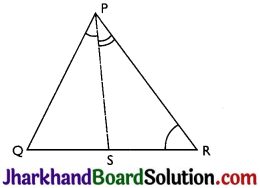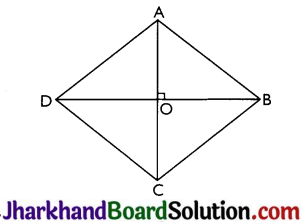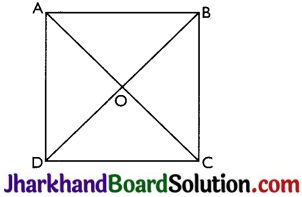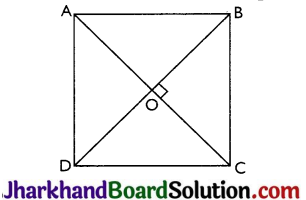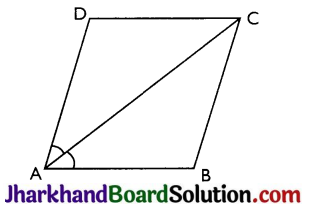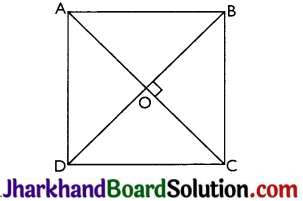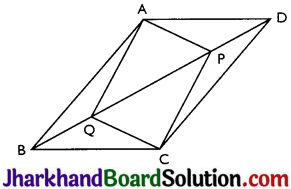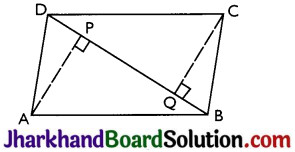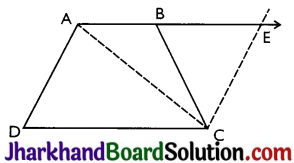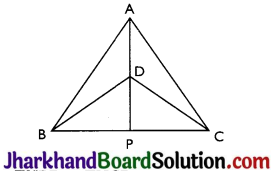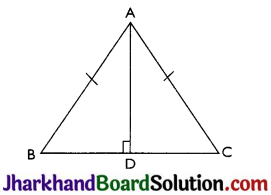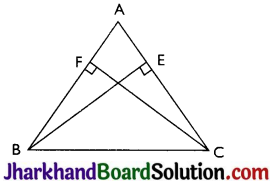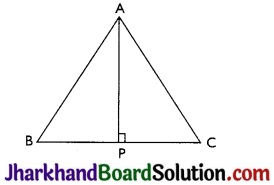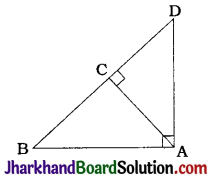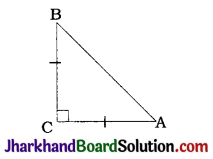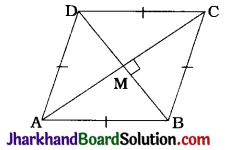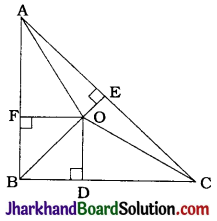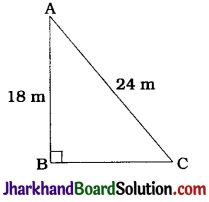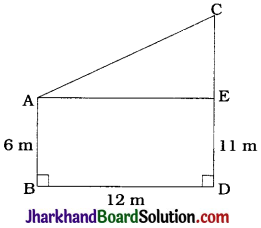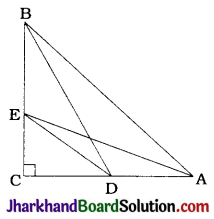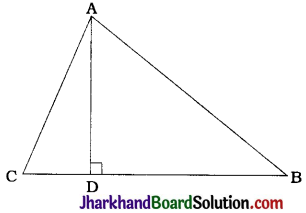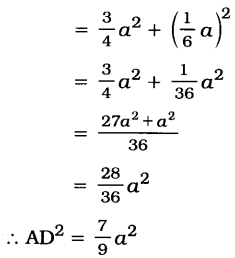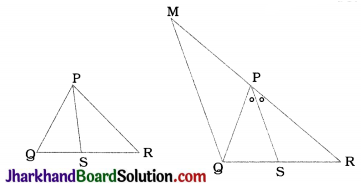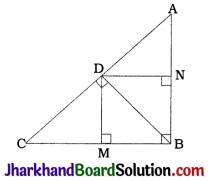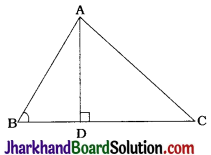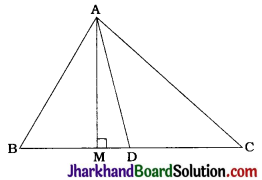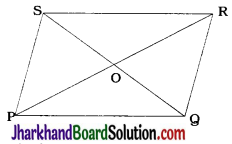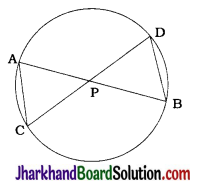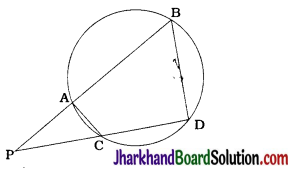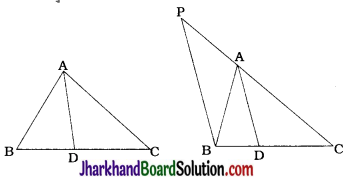Jharkhand Board JAC Class 9 Sanskrit Solutions Shemushi Chapter 2 स्वर्णकाकः Textbook Exercise Questions and Answers.
JAC Board Class 9th Sanskrit Solutions Shemushi Chapter 2 स्वर्णकाकः
JAC Class 9th Sanskrit स्वर्णकाकः Textbook Questions and Answers
1. (अ) एकपदेन उत्तरं लिखत-(एक शब्द में उत्तर लिखिए-)
(क) माता काम् आदिशत्? (माता ने किसको आदेश दिया?)
उत्तरम् :
पुत्रीम् (बेटी को)।
(ख) स्वर्ण-काकः कान् अखादत्? (सोने का कौवा किन्हें खा गया?)
उत्तरम् :
तण्डुलान् (चावलों को)।
(ग) प्रासादः कीदृशः वर्तते? (महल कैसा है?)
उत्तरम् :
स्वर्णमयः (सोने का)।

(घ) गृहमागत्य तया का समुद्घाटिता? (घर आकर उसने क्या खोली?)
उत्तरम् :
मञ्जूषा (पेटी)।
(ङ) लोभाविष्टा बालिका कीदृशीं मञ्जूषां नयति? (लोभी लड़की कैसी मंजूषा को ले जाती है?)
उत्तरम् :
वृहत्तमाम् (सबसे बड़ी को)।
(आ) अधोलिखितानां प्रश्नानाम् उत्तराणि संस्कृतभाषया लिखत – (निम्नलिखित प्रश्नों के उत्तर संस्कृत भाषा में लिखिए-)
(क) निर्धनायाः वृद्धायाः दुहिता कीदृशी आसीत् ? (निर्धन वृद्धा की पुत्री कैसी थी?)
उत्तरम् :
निर्धनायाः वृद्धायाः दुहिता विनम्रा मनोहरा चासीत्। (निर्धन वृद्धा की पुत्री विनम्र और मनोहर थी।)
(ख) बालिकया पूर्वं कीदृशः काकः न दृष्टमः आसीत्? (बालिका के द्वारा पहले कैसा कौआ नहीं देखा गया था?)
उत्तरम् :
बालिकया पूर्वं स्वर्णपक्षो रजतचञ्चुः स्वर्णकाकः न दृष्टः आसीत्।
(बालिका के द्वारा पहले सोने के पंखों वाला, चाँदी की चोंच वाला सुनहला कौआ नहीं देखा गया था।)
(ग) निर्धनायाः दुहिता मञ्जूषायां कानि अपश्यत्? (निर्धना की पुत्री ने मंजूषा में किन्हें देखा?)
उत्तरम् :
निर्धनायाः दुहिता मञ्जूषायां महार्हाणि हीरकाणि अपश्यत्। (निर्धन की पुत्री ने मंजूषा में महँगे हीरे देखे।)
(घ) बालिका किं दृष्ट्वा आश्चर्यचकिता जाता? (बालिका क्या देखकर आश्चर्यचकित हो गई?)
उत्तरम् :
बालिका वृक्षस्योपरि स्वर्णमयं प्रासादं दृष्ट्वा आश्चर्यचकिता जाता।
(बालिका वृक्ष के ऊपर सोने का महल देखकर आश्चर्यचकित हो गई।)

(ङ) गर्विता बालिका कीदृशं सोपानम् अयाचत् कीदृशं च प्राप्नोत्?
(घमण्डी बालिका ने कैसी सीढ़ी माँगी. और कैसी प्राप्त की?)
उत्तरम् :
गर्विता बालिका स्वर्णमयसोपानम् अयाचत् ताम्रमयं च प्राप्नोत्।
(घमण्डी बालिका ने सोने की सीढ़ी माँगी और ताँबे की प्राप्त की।)
2. (क) अधोलिखितानां शब्दानां विलोमपदं पाठात् चित्वा लिखत –
(निम्नलिखित शब्दों के विलोमपद पाठ से चुनकर लिखिए-)
(i) पश्चात् …………
(ii) हसितुम् …………
(ii) अधः …………
(iv) श्वेतः …………
(v) सूर्यास्तः …………
(vi) सुप्तः …………
उत्तरम् :
शब्दः – विलोमपदम्
(i) पश्चात् – पूर्वम्
(ii) अधः – उपरि
(iii) सूर्यास्तः – सूर्योदयः
(iv) हसितुम् – रोदितुम्
(v) श्वेतः – कृष्णः
(vi) सुप्तः – प्रबुद्धः
(ख) सन्धिं कुरुत (संधि करिए-)
(i) नि + अवसत् ………
(ii) सूर्य + उदयः ……….
(iii) वृक्षस्य + उपरि ……….
(iv) हि + अकारयत् ……….
(v) च + एकाकिनी ……….
(vi) इति + उक्त्वा ……….
(vii) प्रति + अवदत् ……….
(viii) प्र. + उक्तम् ……….
(ix) अत्र + एव ……….
(x) तत्र + उपस्थिता ……….
(xi) यथा + इच्छम् ……….
उत्तरम् :
(i) न्यवसत्
(ii) सूर्योदयः
(iii) वृक्षस्योपरि
(iv) ह्यकारयत्
(v) चैकाकिनी
(vi) इत्युक्त्वा
(vii) प्रत्यवदत्
(viii) प्रोक्तम्
(ix) अत्रैव
(x) तत्रोपस्थिता
(xi) यथेच्छम्।

3. स्थूलपदान्यधिकृत्य प्रश्ननिर्माणं कुरुत –
(मोटे छपे शब्दों को आधार बनाकर प्रश्न निर्माण कीजिए-)
(क) ग्रामे निर्धना स्त्री अवसत्। (गाँव में निर्धन स्त्री रहती थी।)
(ख) स्वर्णकाकं निवारयन्ती बालिका प्रार्थयत्। (सुनहले कौए को रोकती हुई बालिका ने प्रार्थना की।)
(ग) सूर्योदयात् पूर्वमेव बालिका तत्रोपस्थिता। (सूर्योदय से पूर्व ही बालिका वहाँ उपस्थित हो गई।)
(घ) बालिका निर्धनमातुः दुहिता आसीत्। (बालिका गरीब माता की पुत्री थी।)
(ङ) लुब्धा वृद्धा स्वर्णकाकस्य रहस्यमभिज्ञातवती। (लोभी वृद्धा सुनहले कौए के रहस्य को जान गई।)
प्रश्न:-
(क) ग्रामे का अवसत्? (गाँव में कौन रहती थी?)
(ख) कं निवारयन्ती बालिका प्रार्थयत्? (किसे रोकती हुई बालिका ने प्रार्थना की?)
(ग) कस्मात् पूर्वमेव बालिका तत्रोपस्थिता? (किससे पहले ही बालिका वहाँ उपस्थित हो गई?)
(घ) बालिका कस्याः दुहिता आसीत् ? (बालिका किसकी पुत्री थी?)
(ङ) लुब्धा वृद्धा कस्य रहस्यमभिज्ञातवती? (लोभी वृद्धा किसके रहस्य को जान गई?)
4. प्रकृति-प्रत्यय-संयोगं कुरुत-(प्रकृति-प्रत्यय का संयोग कीजिए)
(पाठात् चित्वा वा लिखत) अथवा पाठ में से छाँटकर लिखिए।
(क) वि + लोक् + ल्यप् – ……………….
(ख) नि + क्षिप् + ल्यप् – ………………..
(ग) आ + गम् + ल्यप् – ………………..
(घ) दृश् + क्त्वा – …………..
(ङ) शी + क्त्वा – ………………
(च) लघु + तमप् – …………..
उत्तर :
(क) विलोक्य
(ख) निक्षिप्य
(ग) आगम्य/आगत्य
(घ) दृष्ट्वा
(ङ) शयित्वा
(च) लघुतमम्

5. प्रकृतिप्रत्यय-विभागं कुरुत-(प्रकृति-प्रत्यय को अलग कीजिए)
(क) रोदितुम् – ……………
(ख) दृष्ट्वा – ……………
(ग) विलोक्य – ……………
(घ) निक्षिप्य – ……………
(ङ) आगत्य – ………………
(च) शयित्वा – ……………
(छ) लघुतमम् – ……………
उत्तर :
(क) रुद् + तुमुन्
(ख) दृश् + क्त्वा
(ग) वि + लोक् + ल्यप्
(घ) नि + क्षिप् + ल्यप्
(ङ) आ + गम् + ल्यप्
(च) शी + क्त्वा
(छ) लघु + तमप्
6. अधोलिखितानि कथनानि कः/का, कं/ काम् च कथयति –
(निम्नलिखित कथनों को कौन किससे कहता है-)

उत्तर :
क:/का – कं/काम्
(क) स्वर्णकाकः (सुनहला कौआ) – बालिकाम् (बालिका से)
(ख) निर्धना वृद्धा (निर्धन वृद्धा) – पुत्रीम् (पुत्री से)
(ग) निर्धना बालिका (निर्धन बालिका) स्वर्णकाकम् (सुनहले कौए से)
(घ) स्वर्णकाकः (सुनहला कौआ) – निर्धनां बालिकाम् (निर्धन बालिका से)
(ङ) गर्विता बालिका (घमण्डी बालिका) – स्वर्णकाकम् (सुनहले कौए से)

7. उदाहरणमनुसृत्य कोष्ठकगतेषु पदेषु पञ्चमीविभक्तेः प्रयोगं कृत्वा रिक्तस्थानानि पूरयत –
(उदाहरणानुसार कोष्ठक में दिये गये पदों में पंचमी विभक्ति का प्रयोग कर रिक्त-स्थानों की पूर्ति कीजिए-) यथा – मूषकः बिलाद् बहिः निर्गच्छति। (बिल)
(क) जनः ……………. बहिः आगच्छति। (ग्राम)
(ख) नद्यः …………….. निस्सरन्ति। (पर्वत)
(ग)……………. पत्राणि पतन्ति। (वृक्ष)
(घ) बालकः ……………. विभेति। (सिंह)
(ङ) ईश्वरः…………………त्रायते। (क्लेश)
(च) प्रभुः भक्तं ………….. निवारयति। (पाप)
उत्तर :
(क) ग्रामात्
(ख) पर्वतेभ्यः
(ग) वृक्षात्
(घ) सिंहात्
(ङ) क्लेशात्
(च) पापात्।
JAC Class 9th Sanskrit स्वर्णकाकः Important Questions and Answers
प्रश्न: 1.
ग्रामे का न्यवसत्? (गाँव में कौन रहती थी?)
उत्तरम् :
ग्रामे एका निर्धना वृद्धा स्त्री न्यवसत्। (गाँव में एक गरीब वृद्धा स्त्री रहती थी।)
प्रश्न: 2.
माता किम् अकरोत्? (माता ने क्या किया?)
उत्तरम् :
माता स्थाल्यां तण्डुलान् निक्षिप्य पुत्री तद्रक्षणाय आदिदेश। (माता ने थाली में चावलों को रखकर पुत्री को उनकी रक्षा करने का आदेश दिया।)

प्रश्न: 3.
किञ्चित् कालादनन्तरं किम् अभवत्? (कुछ समय पश्चात् क्या हुआ?)
उत्तरम् :
किञ्चित् कालादनन्तरम् एकः विचित्रः काकः समुड्डीय तामुपजगाम। (कुछ समय पश्चात् एक विचित्र कौआ उड़कर उसके पास आया।)
प्रश्न: 4.
बालिकया कीदृशः काकः पूर्वं न दृष्टः? (बालिका ने कैसा कौआ पहले नहीं देखा था?)
उत्तरम् :
बालिकया स्वर्णपक्षो रजतचञ्चुः स्वर्णकाकः पूर्वं न दृष्टः। (बालिका ने सोने के पंखों वाला चाँदी की चोंच वाला सुनहला कौआ पहले नहीं देखा था।) .
प्रश्न: 5.
बालिका काकं किं प्रार्थयत्? (बालिका ने कौए से क्या प्रार्थना की?)
उत्तरम् :
बालिका काकं प्रार्थयत्-तण्डुलान् मा भक्षय। मदीया माता अतीव निर्धना वर्तते। (बालिका ने कौए से प्रार्थना की-चावलों को मत खाओ। मेरी माता बहुत गरीब है।)
प्रश्न: 6.
किं विलोक्य बालिका रोदितुम् आरब्धा? (क्या देखकर ..लिका ने रोना प्रारम्भ कर दिया?)
उत्तरम् :
काकं तण्डुलान् खादन्तं हसन्तञ्च विलोक्य बालिका रोदितुम् आरब्धा। . (कौए को चावलों को खाते हुए और हँसते हुए देखकर बालिका ने रोना आरम्भ कर दिया।)
प्रश्न: 7.
बालिका (कन्या) ग्रामात बहिः कदा उपस्थिता? (बालिका गाँव से बाहर कब उपस्थित हो गई?)
उत्तरम् :
बालिका सूर्योदयात्पूर्वमेव ग्रामात् बहिः उपस्थिता। (बालिका सूर्योदय से पूर्व ही गाँव से बाहर उपस्थित हो गई।)

प्रश्न: 8.
बालिकां वृक्षस्य अधः दृष्ट्वा काकेन किं कथितम्? (वृक्ष के नीचे बालिका को देखकर कौए ने क्या कहा?)
उत्तरम् :
काकेन कथितम्-हं हो. बाले! त्वमागता, तिष्ठ, अहं त्वत्कृते सोपानमवतारयामि, तत्कथय स्वर्णमयं रजतमयमुत ताम्रमयं वा। (कौए ने कहा-अरे बालिके तुम आ गई, ठहरो, मैं तुम्हारे लिए सीढ़ी उतारता हूँ, तो कहो सोने की या चाँदी की अथवा ताँबे की।)
प्रश्न: 9.
सोपानविषये कन्या काकं किं प्रावोचत? (सीढी के विषय में बालिका ने कौए से क्या कहा?)
उत्तरम् :
कन्या काकं प्रावोचत्-अहं निर्धनमातुर्दुहिता अस्मि। ताम्रसोपानेनैव आगमिष्यामि। (बालिका ने कौए से कहा-मैं निर्धन माता की पुत्री हूँ। ताँबे की सीढ़ी से ही आऊँगी।)
प्रश्न: 10.
श्रान्तां कन्यां विलोक्य काकः किं प्राह? (कन्या को थकी हुई देखकर कौए नें क्या कहा?)
उत्तरम् :
कन्यां श्रान्तां विलोक्य काकः प्राह-पूर्वं लघुप्रातराशः क्रियताम्। (बालिका को थकी हुई देखकर कौआ बोला-पहले थोड़ा-सा सुबह का नाश्ता कर लो।)
प्रश्न: 11.
बालिका स्थाल्याविषये किं व्याजहार? (बालिका ने थाली के विषय में क्या कहा?)
उत्तरम् :
स्थाल्याविषये बालिका व्याजहार-ताम्रस्थाल्यामेवाहं निर्धना भोजनं करिष्यामि। (थाली के विषय में बालिका ने कहा-मैं गरीब हूँ, (इसलिए) ताँबे की थाली में ही भोजन करूँगी।)

प्रश्न: 12.
प्रातराशकाले कन्या कदा आश्चर्यचकिता जाता? (नाश्ते के समय बालिका कब आश्चर्यचकित हो गई?)
उत्तरम् :
कन्या तदा आश्चर्यचकिता सञ्जाता यदा स्वर्णकाकेन स्वर्णस्थाल्यां भोजनं परिवेषितम्। (बालिका तब आश्चर्यचकित हो गई जब सुनहले कौए ने सोने की थाली में भोजन परोसा।)
प्रश्न: 13.
अन्ते काकः किं ब्रूते? (अन्त में कौए ने क्या कहा?)
उत्तरम् :
अन्ते काक: ब्रूते-बालिके! अहम् इच्छामि यत् त्वं सर्वदा अत्रैव तिष्ठ परं तव माता एकाकिनी वर्तते। (अन्त में कौए ने कहा-बालिका! मैं चाहता हूँ कि तुम हमेशा यहीं पर ठहरो लेकिन तुम्हारी माँ अकेली है।)
प्रश्न: 14.
काकः कक्षाभ्यन्तरात् किम् आनयत्? (कौआ कमरे के अन्दर से क्या लाया?)
उत्तरम् :
काकः कक्षाभ्यन्तरात् तिस्रः मञ्जूषाः आनयत्। (कौआ कमरे के अन्दर से तीन सन्दूकें लाया।)
प्रश्न: 15.
मञ्जूषाः निस्सार्य काकः बालिकां किम् अवदत्? (सन्दूकें निकालकर कौए ने बालिका से क्या कहा?)
उत्तरम् :
काकः बालिकाम् अवदत्-बालिके! यथेच्छं गृहाण मञ्जूषामेकाम्। (कौआ बालिका से बोला-बालिका! इच्छानुसार एक सन्दूक ग्रहण करो।)
प्रश्न: 16.
बालिका का मञ्जूषां गृहीतवती? (बालिका ने कौनसा सन्दूक लिया?)
उत्तरम् :
बालिका लघुतमां मञ्जूषां गृहीतवती। (बालिका ने सबसे छोटा सन्दूक लिया।)

प्रश्न: 17.
मञ्जूषां प्रगृह्य बालिकया किं कथितम्? (सन्दूक को लेकर बालिका ने क्या कहा?)
उत्तरम् :
मञ्जूषा प्रगृह्य बालिकया कथितम्-इयत् एव मदीयतण्डुलाना मूल्यम्। (सन्दूक लेकर बालिका ने कहा-इतना ही मेरे चावलों का मूल्य है।)
प्रश्न: 18.
मञ्जूषां समुद्घाट्य बालिका तस्यां किम् अपश्यत्? (सन्दूक को खोलकर बालिका ने उसमें क्या देखा?)
उत्तरम् :
मञ्जूषां समुद्घाट्य बालिका तस्यां महार्हाणि हीरकाणि अपश्यत्। (सन्दूक को खोलकर बालिका ने उसमें बहुमूल्य हीरों को देखा।)
प्रश्न: 19.
अपरा वृद्धा कस्य रहस्यम् अभिज्ञातवती? (दूसरी वृद्धा किसके रहस्य को जान गई?)
उत्तरम् :
अपरा वृद्धा स्वर्णकाकस्य रहस्यम् अभिज्ञातवती। (दूसरी वृद्धा सुनहले कौए के रहस्य को जान गई।)
प्रश्न: 20.
काकः निर्धनायै बालिकायै किं दातुम् अकथयत्? (कौए ने निर्धन बालिका के लिए क्या देने को कहा?)
उत्तरम् :
काकः निर्धनायै बालिकायै तण्डुलमूल्यं दातुम् अकथयत्। (कौए ने निर्धन बालिका के लिए चावलों का मूल्य देने को कहा।)
प्रश्न: 21.
निर्धना कन्या कीदृशं सोपानं अवतारयितुम् अकथयत्? (गरीब कन्या ने कैसी सीढ़ी उतारने को कहा?)
उत्तरम् :
निर्धना कन्या ताम्रसोपानम् अवतारयितुम् अकथयत्। (गरीब कन्या ने ताँबे की सीढ़ी उतारने को कहा।)
प्रश्न: 22.
निर्धनां बालिका काकः कति मञ्जूषाः ग्रहीतुम् अकथयत्? (कौए ने निर्धन बालिका से कितनी सन्दूकें लेने को कहा?)
उत्तरम् :
काकः निर्धनां बालिकाम् एकां मञ्जूषां ग्रहीतुम् अकथयत्। (कौए ने निर्धन बालिका से एक सन्दूक लेने को कहा।) ।

प्रश्न: 23.
लुब्धया बालिकया का मञ्जूषा गृहीता? (लोभी बालिका ने कौन-सी सन्दूक ग्रहण की?)
उत्तरम् :
लुब्धया बालिकया बृहत्तमा मञ्जूषा गृहीता। (लोभी बालिका ने सबसे बड़ी सन्दूक ग्रहण की।)
रेखांकित पदान्यधिकृत्य प्रश्न निर्माणं कुरुत-(रेखांकित पदों के आधार पर प्रश्न निर्माण करिए-)
प्रश्न: 1.
स्वर्णकाकः इति कथायां लोभस्य परिणामो वर्णितः। (स्वर्णकाकः कहानी में लोभ का परिणाम वर्णित है।)
उत्तरम् :
स्वर्णकाकः इति कथायां कस्य परिणामो वर्णित:? (इस कहानी में किसका परिणाम वर्णित है?)
प्रश्न: 2.
दुहिता विनम्रा मनोहरा चासीत्। (बेटी विनम्र और मनोहर थी।)
उत्तरम् :
दुहिता कीदृशी आसीत् ? (बेटी कैसी थी?)
प्रश्न: 3.
स्थाल्यां तण्डुलान् निक्षिप्य पुत्रीम् आदिशत्। (थाली में चावल रखकर बेटी को आदेश दिया।)
उत्तरम् :
स्थाल्यां कान् निक्षिप्य पुत्रीम् आदिशत्? (थाली में किन्हें रखकर बेटी को आदेश दिया।)
प्रश्न: 4.
बालिका रोदितुमारब्धा। (बालिका ने रोना आरम्भ किया।)
उत्तरम् :
का रोदितुमारब्धा? (किसने रोना आरम्भ किया?)

प्रश्नः 5.
सूर्योदयात्पूर्वमेव सा तत्रोपस्थिता। (सूर्योदय से पूर्व ही वह वहाँ उपस्थित हो गई।)
उत्तरम् :
सा तत्र कदा उपस्थिता? (वह वहाँ कब उपस्थित हुई?)
प्रश्न: 6.
सा स्वर्णसोपानेन स्वर्णभवनम् आरोहत। (वह सोने की सीढ़ी से स्वर्ण-भवन पर चढ़ी।)
उत्तरम् :
सा केन स्वर्णभवनम् आरोहत? (वह किससे सोने के भवन पर चढ़ी?)
प्रश्नः 7.
तदा सा आश्चर्यचकिता सजाता? (तब वह आश्चर्यचकित हो गई।)
उत्तरम् :
तदा सा कीदृशी सञ्जाता? (तब वह कैसी हो गई?)
प्रश्नः 8.
स्वर्णकाकेन स्वर्णस्थाल्यां भोजनं परिवेषितम्। (स्वर्ण काक द्वारा सोने की थाली में भोजन परोसा गया।)
उत्तरम् :
स्वर्णकाकेन कस्यां भोजनं परिवेषितम्? (स्वर्ण काक ने किसमें भोजन परोसा?)
प्रश्न: 9.
काकः कक्षाभ्यन्तरात् तिस्त्रः मञ्जूषा निस्सार्य अददात्। (कौए ने कमरे के अन्दर से तीन पेटी निकालकर दी।)
उत्तरम् :
काकः कुतः तिस्त्रः मञ्जूषा निस्सार्य अददात्। (कौए ने कहाँ से तीन पेटी निकालकर दी।)

प्रश्न: 10.
लुब्धया बालिकया लोभस्य फलं प्राप्तम्? (लोभी बालिका द्वारा लोभ का फल प्राप्त किया गया।)
उत्तरम् :
कया लोभस्य फलं प्राप्तम्? (किसके द्वारा लोभ का फल प्राप्त किया गया?)
कथाक्रम-संयोजनम् अधोलिखितवाक्यानि पठित्वा कथाक्रमसंयोजनं कुरुत (निम्नलिखित वाक्यों को पढ़कर कथा-क्रम-संयोजन कीजिए)
- ईय॑या सा तस्य स्वर्णकाकस्य रहस्यमभिज्ञातवती।
- तस्मिन्नेव ग्रामे एकाऽपरा लुब्धा वृद्धा न्यवसत्।
- लघुतमा मञ्जूषां प्रगृह्य बालिकया कथितमियदेव मदीयतण्डुलानां मूल्यम्।
- काकः प्राह-पूर्वं लघुप्रातराशः क्रियताम्।
- भवने चित्रविचित्रवस्तूनि सज्जितानि दृष्ट्वा सा विस्मयं गता।
- सूर्योदयात्पूर्वमेव सा तत्रोपस्थिता।
- नैतादृशः स्वर्णपक्षो रजतचञ्चुः स्वर्णकाकस्तया पूर्वं दृष्टः।
- तस्याश्चैका दुहिता विनम्रा मनोहरा चासीत्।
उत्तरम् :
- तस्याश्चैका दुहिता विनम्रा मनोहरा चासीत्।
- नैतादृशः स्वर्णपक्षो रजतचञ्चुः स्वर्णकाकस्तया पूर्वं दृष्टः।
- सूर्योदयात्पूर्वमेव सा तत्रोपस्थिता।
- भवने चित्रविचित्रवस्तूनि सज्जितानि दृष्ट्वा सा विस्मयं गता।
- काकः प्राह-पूर्वं लघुप्रातराशः क्रियताम्।
- लघुतमा मञ्जूषां प्रगृह्य बालिकया कथितमियदेव मदीयतण्डुलानां मूल्यम्।
- तस्मिन्नेव ग्रामे एकाऽपरा लुब्धा वृद्धा न्यवसत्।
- ईय॑या सा तस्य स्वर्णकाकस्य रहस्यमभिज्ञातवती।
भाषिक-विस्तार –
1. किसी भी काम को करके’ इस अर्थ में ‘क्त्वा’ प्रत्यय का प्रयोग किया जाता है। यथा-
पठित्वा – पठ् + क्त्वा = पढ़कर
गत्वा – गम् + क्त्वा = जाकर
खादित्वा – खाद् + क्त्वा = खाकर

इसी अर्थ में अगर धातु (क्रिया) से पहले उपसर्ग होता है तो ल्यप् प्रत्यय का प्रयोग होता है। धातु से पूर्व उपसर्ग होने की स्थिति में कभी भी ‘क्त्वा’ प्रत्यय नहीं हो सकता और उपसर्ग न होने की स्थिति में कभी भी ल्यप् प्रत्यय नहीं हो सकता है। यथा –
उप + गम् + ल्यप् = उपगम्य
सम् + पूज् + ल्यप् = सम्पूज्य
वि + विलोक्य आ + ल्यप् = आदाय
निर् + गम् + ल्यप् = निर्गत्य
2. प्रश्नवाचक शब्दों को अनिश्चयवाचक बनाने के लिए चित् और चन निपातों का प्रयोग किया जाता है। ये निपात जब सर्वनाम पदों के साथ लगते हैं तो सर्वनाम पद होते हैं और जब अव्यय पदों के साथ प्रयुक्त होते हैं तो अव्यय होते हैं।
यथा – कः = कौन
कः + चन = कश्चन = कोई
कः + चित् = कश्चित् = कोई
के + चन = केचन = कोई (बहुवचन में)
के + चित् = केचित् (बहुवचन में)
का + चन = काचन = कोई (स्त्री)
का + चित् = काचित् (कोई स्त्री)
काः + चन = काश्चन = कुछ स्त्रियाँ (बहुवचन में)
काः+ चित् = काश्चित् (कुछ स्त्रियाँ) (बहुवचन में)

“किम्’ शब्द के सभी वचनों, लिंगों व सभी विभक्तियों में ‘चित्’ और ‘चन’ का प्रयोग किया जा सकता है और उसे अनिश्चयवाचक बनाया जा सकता है।
जैसे- (i) किञ्चित्-प्रथमा में
(ii) केनचित्-तृतीया में
(iii) केषाञ्चित् (केषाम् + चित्)-षष्ठी में
(iv) कस्मिंश्चित्-सप्तमी में
(v) कस्याञ्चित्-सप्तमी (स्त्रीलिङ्ग में)
इस तरह ‘चित्’ के स्थान पर ‘चन’ का प्रयोग होता है। ‘चित्’ और ‘चन’ जब अव्यय पदों में लग जाते हैं तो वे अव्यय हो जाते हैं। जैसे- क्वचित्-क्वचन कदाचित्-कदाचन
3. संस्कृत में एक से चतुर् (चार) तक संख्यावाची शब्द पुल्लिङ्ग, स्त्रीलिङ्ग तथा नपुंसकलिङ्ग में अलग-अलग रूपों में होते हैं पर पञ्च (पाँच) से उनका रूप सभी लिङ्गों में एक-सा होता है।

स्वर्णकाकः Summary and Translation in Hindi
पाठ परिचयः – प्रस्तुत पाठ श्री पद्मशास्त्री द्वारा विरचित ‘विश्वकथाशतकम्’ नामक कथासंग्रह से लिया गया है। जिसमें विभिन्न देशों की सौ लोक कथाओं का संग्रह है। यह वर्मा देश की श्रेष्ठतम कथाओं में से एक है, जिसमें लोभ और उसके दुष्परिणामों के साथ-साथ त्याग और उसके सुपरिणामों का वर्णन एक ‘सुनहले पंखों वाले कौए’ के माध् यम से किया गया है।
प्राचीन समय में एक गाँव में एक वृद्ध स्त्री रहती थी। उसकी पुत्री विनम्र और सुन्दर थी। एक बार माता ने उससे धूप में रखे चावलों की पक्षियों से रक्षा करने को कहा। कुछ समय पश्चात् एक सुनहले पंखों वाला कौआ उड़ता हुआ वहाँ पहुँचा और चावलों को खाने लगा।
लड़की के मना करने पर उस कौए ने उस लड़की से सूर्योदय से पहले गाँव के बाहर पीपल के पेड़ के नीचे आकर चावलों का मूल्य लेने को कहा। जब सूर्योदय से पहले वह लड़की वहाँ पहुँची तो उस लड़की ने वृक्ष के ऊपर सोने का महल देखा। लड़की की त्याग-भावना से प्रसन्न हुए कौए ने उस लड़की को सोने की सीढ़ी से ऊपर चढ़ाया तथा सोने की थाली में स्वादिष्ट भोजन कराया। लड़की ने कौए द्वारा दी गयी तीन सन्दूकों में से सबसे छोटी सन्दूक को चावलों के मूल्य के रूप में स्वीकार किया। लड़की ने घर पहुँचकर सन्दूक को खोलकर देखा, उस सन्दूक में भरे हीरों को देखकर वह बहुत प्रसन्न हुई और वह उसी दिन से धनिक बन गई।
उसी गाँव की एक लालची स्त्री को जब उस निर्धन लड़की के धनिक बनने का पता चला तो उस लालची स्त्री ने भी अपनी पुत्री से धूप में रखे चावलों की पक्षियों से रक्षा करने को कहा। जब वह सुनहला कौआ वहाँ पहुँचकर चावलों को खाने लगा तो उस कौए को लड़की ने भी उन चावलों को खाने से रोका। कौए ने उस लड़की से भी सूर्योदय से पूर्व ! गाँव के बाहर पीपल के वृक्ष के नीचे आने को कहा। वह लड़की सूर्योदय से पहले वहाँ पहुँचकर कौए की निन्दा करने । लगी और चावलों का मूल्य माँगने लगी।
कौए द्वारा सीढ़ियों की पूछने पर अभिमानी लड़की बोली कि सोने की सीढ़ियों से आऊँगी, परन्तु ‘सुनहले पंखों वाले कौए’ ने उसके लिए ताँबे की सीढ़ी दी। कौए ने उस लड़की को भोजन भी ताम्रपात्र में कराया। कौए द्वारा दी गई तीन पेटियों में से सबसे बड़ी पेटी लेकर वह खुशी-खुशी घर लौटी और जब उस लड़की ने उस पेटी को खोलकर देखा तो भयंकर काले साँप के रूप में अपने लोभ के फल को प्राप्त कर दुःखी हुई। इसके पश्चात् उसने लालच करना छोड़ दिया।
मूलपाठः, शब्दार्थाः, सप्रसंग हिन्दी-अनुवादः, सप्रसंग संस्कृत-व्यारव्याः अवबोधन कार्यम् च । __ 1. पुरा कस्मिंश्चिद् ग्रामे एका निर्धना वृद्धा स्त्री न्यवसत्। तस्याः च एका दुहिता विनम्रा मनोहरा चासीत्। एकदा माता स्थाल्यां तण्डुलान् निक्षिप्य पुत्रीम् आदिशत्। “सूर्यातपे तण्डुलान् खगेभ्यो रक्षा” किञ्चित् कालादनन्तरम् एको विचित्रः काकः समुड्डीय तस्याः समीपम् अगच्छत्।
नैतादृशः स्वर्णपक्षो रजतचञ्चुः स्वर्णकाकस्तया पूर्वं दृष्टः। तं तण्डुलान् खादन्तं हसन्तञ्च विलोक्य बालिका रोदितुमारब्धा। तं निवारयन्ती सा प्रार्थयत्- “तण्डुलान् मा भक्षया मदीया माता अतीव निर्धना वर्तते।” स्वर्णपक्षः काकः प्रोवाच, “मा शुचः। सूर्योदयात्प्राग् ग्रामाद्बहिः पिप्पलवृक्षमनु त्वया आगन्तव्यम्। अहं तुभ्यं तण्डुलमूल्यं दास्यामि।” प्रहर्षिता बालिका निद्रामपि न लेभे।

शब्दार्थाः – पुरा = प्राचीनकाले (प्राचीन समय में), कस्मिंश्चिद् = कस्मिन् चित् (किसी), ग्रामे = वसथे (गाँव में), एका निर्धना = एका दरिद्रा (एक गरीब), स्त्री = वनिता (महिला/स्त्री), न्यवसत् = वसति स्म (रहती थी), तस्याः = (उसकी), एका दुहिता = एका पुत्री (एक पुत्री), विनम्रा = विनयशीला (विनम्र), मनोहरा = हृदयहारिणी (मनोहर), च = और, आसीत् = अवर्तत (थी), एकदा = एकस्मिन् दिवसे (एक बार), माता = जननी (माता ने), स्थाल्याम् = स्थालीपात्रे (थाली में), तण्डुलान् = अक्षतान् (चावलों को), निक्षिप्य = प्रसार्य (फैलाकर/रखकर), पुत्रीम आदिशत् = आदेशमददत् (आदेश दिया), सूर्यातपे = आतपे (धूप में),
तण्डुलान् = अक्षतान् (चावलों को), खगेभ्यः = विहगेभ्यः (पक्षियों से), रक्ष = रक्षणं कुरु (रक्षा करो), किञ्चित् कालादनन्तरम् = ईषत् समयपश्चात् (कुछ समय के पश्चात्), एको विचित्रः काकः = एकः विचित्र: वायसः (एक अजीब कौआ), समुड्डीय = उत्प्लुत्य (उड़कर), तस्याः समीपम् अगच्छत् = ताम् समीपम् आगतवान् (उसके पास पहुँचा), न = मा (नहीं), एतादृशः = एतस्य प्रकारस्य (इस प्रकार का), स्वर्णपक्षः = स्वर्णमये पक्षे यस्य सः (सोने के पंखों वाला), रजतचञ्चुः = रजतमय: चञ्चुः यस्य सः (चाँदी की चोंच वाला), स्वर्णकाकः = स्वर्णस्य वायसः (सोने का कौआ/सुनहला कौआ), तया = (उस (लड़की) के द्वारा),
पूर्वम् = पुरा (पहले), दृष्टः = अपश्यत् (देखा था), तम् = उस (कौए) को), तण्डुलान् = अक्षतान् (चावलों को), खादन्तम् = भक्षयन्तम् (खाते हुए), हसन्तम् = हास्यं कुर्वन्तम् (हँसते हुए), च = और, विलोक्य = दृष्ट्वा (देखकर), बालिका = कन्या (उस लड़की ने), रोदितुम् = विलपितुम् (रोना), आरब्धा = प्रारम्भम् अकरोत् (शुरू कर दिया), तम् = (उस कौए को), निवारयन्ती = वारणं कुर्वन्ती (रोकती हुई), सा = (वह), प्रार्थयत् = न्यवेदयत् (प्रार्थना करने लगी), तण्डुलान् = अक्षतान् (चावलों को), मा = न (नहीं/मत), भक्षय = खाद (खाओ), मदीया = मम (मेरी), माता = जननी (माता), अतीव = अत्यन्तम् (अत्यन्त/अत्यधिक),
निधन = वित्तहीना/दरिद्रा (गरीब), वर्तते = अस्ति (है), स्वर्णपक्षः काकः = स्वर्णमये पक्षे यस्य सः (सोने के पंखों वाला/सुनहला कौआ), प्रोवाच = अकथयत् (कहा), मा शुचः = शोक मा कुरु (शोक मत करो), सूर्योदयात्प्राग् = भानूदयात् पूर्वम् (सूर्योदय से पहले), ग्रामाबहिः = गाँव के बाहर, पिप्पलवृक्षमनु = पिप्पलतरो: अधः (पीपल के पेड़ के नीचे), त्वया = भवत्या (तुम्हारे द्वारा), आगन्तव्यम् = आगच्छेत् (आना चाहिए), अहम् = मैं, तुभ्यम् = ते/भवत्यै (तुम्हारे लिए), तण्डुलमूल्यम् = अक्षतमूल्यम् (चावलों का मूल्य), दास्यामि = अर्पणं करिष्यामि (दूँगा), प्रहर्षिता = प्रसन्ना (खुश हुई), बालिका = कन्या (लड़की ने), निद्रामपि न लेभे = शयनम् अपि न प्राप्तम् अकरोत् (नींद भी नहीं ली/सोई भी नहीं)।
हिन्दी-अनुवादः
सन्दर्भ – प्रस्तुत गद्यांश श्रीपद्मशास्त्री द्वारा रचित ‘विश्वकथाशतकम्’ नामक कथा-संग्रह से उद्धृत ‘स्वर्णकाक:’. नामक पाठ से अवतरित है।
प्रसंग – प्रस्तुत गद्यांश में धूप में रखे बालिका द्वारा रक्षित चावलों को सुनहले कौए द्वारा खाने और चावलों का मूल्य चुकाने के लिए कहने का वर्णन है।
हिन्दी-अनुवाद – प्राचीन समय में किसी गाँव में एक गरीब वृद्ध महिला रहती थी। उसकी एक विनम्र और मनोहर पुत्री थी। एक बार माता ने थाली में चावलों को रखकर पुत्री को आदेश दिया-धूप में रखे चावलों की पक्षियों से रक्षा करना। कुछ समय पश्चात् एक अजीब कौआ उड़कर उसके पास पहुँचा।
इस प्रकार का सोने के पंखों वाला, चाँदी की चोंच वाला सुनहला कौआ उसने पहले नहीं देखा था। उसको चावलों को खाता हुआ और हँसता हुआ देखकर लड़की ने रोना शुरू कर दिया। उसको रोकते हुए वह प्रार्थना करने लगी-चावलों को मत खाओ। मेरी माता बहुत गरीब है। सुनहला कौआ बोला-दुखी मत होओ। तुम सूर्योदय से पहले गाँव के बाहर पीपल के पेड़ के नीचे आना। मैं तुम्हें चावलों का मूल्य दूंगा। खुश (प्रसन्न) हुई लड़की को नींद भी नहीं आई अर्थात् वह सोई भी नहीं।
संस्कत-व्याख्याः
सन्दर्भ: – प्रस्तुतगद्यांशः अस्माकं पाठ्यपुस्तकात् शेमुष्याः ‘स्वर्णकाकः’ नामक पाठात् अवतरितोऽस्ति। प्रस्तुतपाठः श्री पद्मशास्त्रिणा विरचितात् ‘विश्वकथाशतकम्’ नामक कथासंग्रहात् सङ्कलितः अस्ति। (प्रस्तुत गद्यांश हमारी पाठ्यपुस्तक. ‘शेमुषी’ के ‘स्वर्णकाकः’ नामक पाठ से लिया गया है। प्रस्तुत पाठ श्री पद्म शास्त्री द्वारा रचित ‘विश्वकथाशतकम्’ नाम के कथा ग्रन्थ से संकलित है।)
प्रसङ्गः – प्रस्तुतगद्यांशे वर्णितं यदेक: स्वर्णकाकः सूर्यातपे स्थाल्यां स्थितान् बालिकया रक्षितान् अक्षतान् खादति तेषां मूल्यं च प्रदातुं कथयति। (प्रस्तुत गद्यांश में वर्णित है कि एक सोने का कौआ धूप में थाली में रखे चावलों को खाता है और उनका मूल्य चुकाने के लिए कहता है।)
व्याख्याः – प्राचीनकाले कस्मिन् अपि वसथे (ग्रामे) एका दरिद्रा वृद्धा वनिता (स्त्री) वसति स्म। तस्याः एका विनयशीला हृदयहारिणी च पुत्री आसीत्। एकस्मिन् दिवसे जननी स्थाल्यां अक्षतान् प्रसार्य सुतायै आदेशम् अददात् यत् सूर्यातपे अक्षतानां विहगेभ्यः रक्षणं कुरु। ईषत् समयपश्चात् एकः विचित्रवायसः उत्प्लुत्य तस्याः समीपम् आगच्छत् । न तस्य प्रकारस्य हेममयः पक्षः रजतमयः चञ्चुः स्वर्णकाकः एतया पुरा दृष्टः। तम् (स्वर्णकाकम्) अक्षतान् भक्षयन्तम् हास्यं च कुर्वन्तं दृष्ट्वा सा कन्या विलपितुम् आरभत।
काकं वारयन्ती सा न्यवेदयत्- अक्षतान् मा खाद। मम जननी अत्यन्त दरिद्रा अस्ति। हेममयः पक्षः वायसः अकथयत्-शोकं मा कुरु। भानूदयात् पूर्वं ग्रामात् बहिः पिप्पलतरा: अधः भवती आगच्छे। अहं भवत्यै अक्षतमूल्यम् अर्पणं करिष्यामि। प्रसन्ना कन्या शयनम् अपि न प्राप्तम् अकरोत्। (प्राचीनकाल में किरा में एक गरीब बुढ़िया रहती थी। उसकी एक विनम्र, हृदय को हरण करने वाली बेटी थी। एक दिन माता ने थाली में चावलों को फैलाकर पुत्री को आदेश दिया कि सूर्य की धूप तक चावलों की पक्षियों से रक्षा करो।
कुछ समय बाद एक विचित्र कौआ उड़कर उसके पास आया। इस प्रकार का सोने के पंखों वाला और चाँदी की चोंच वाला कौआ इससे पहले नहीं देखा गया। उस (सोने के कौवे) को चावल चुगते हुए और हँसते हुए को देखकर वह कन्या रोने लगी। कौए को रोकती हुई उसने निवेदन किया-“चावलों को मत खाओ। मेरी माता बहुत गरीब है।” सोने की चोंच वाले कौवे ने कहा-“दुखी मत हो। सूरज निकलने से पहले गाँव के बाहर पीपल के नीचे आप आ जाना। मैं आपके लिए चावलों का मूल्य सौंप दूंगा।” खुश हुई कन्या सो भी नहीं पाई।)

अवबोधन कार्यम्
प्रश्न 1.
एकपदेन उत्तरत- (एक शब्द में उत्तर दीजिए-)
(क) बालिका तण्डुलान् केभ्यः रक्षेतु? (बालिका किनसे चावलों की रक्षा करे?)
(ख) ‘तण्डुलान् मा खादय’ इति कोऽवदत्? (‘चावल मत खाओ’ ऐसा किसने कहा?)
प्रश्न 2.
पूर्णवाक्येन उत्तरत – (पूरे वाक्य में उत्तर दीजिए-)
(क) बालिका केन कारणेन रोदितुम् आरब्धा? (बालिका किस कारण से रोई ?)
(ख) कीदृशः काकः बालिकया पूर्वं न दृष्टः? (बालिका ने कैसा कौआ पहले नहीं देखा?)
प्रश्न 3.
यथानिर्देशम् उत्तरत-(निर्देशानुसार उत्तर दीजिए-)
(क) “स्वर्णपक्षी’ इत्यत्र किं पदं विशेषण पदम् ?। (‘स्वर्णपक्षी’ इनमें कौनसा पद विशेषण पद है?)
(ख) ‘धनविहीना’ इति पदस्य समानार्थी गद्यांशात् चित्वा लिखत।
(‘धनविहीना’ इस पद का समानार्थी पद गद्यांश से लिखिए।)
उत्तराणि :
(1) (क) खगेभ्यः। (पक्षियों से)।
(ख) बालिका (लड़की ने)।
(2) (क) तण्डुलान् खादन्तं हसन्तं तं काकम् अवलोक्य बालिका रोदितुम् आरब्धा। (चावलों को खाते हुए हँसते हुए उस कौआ को देखकर लड़की रोने लगी।)
(ख) नैतादृशः स्वर्णपक्षो रजतचञ्चुः स्वर्ण काकस्तया पूर्व दृष्टः। (ऐसा सोने की पंखों और चाँदी की चोंच वाला सोने का कौए उसने पहले नहीं देखा था।)
(3) (क) स्वर्ण (सोना)।
(ख) निर्धना (गरीब)।
2. सूर्योदयात्पूर्वमेव सा तत्रोपस्थिता। वृक्षस्योपरि विलोक्य सा च आश्चर्यचकिता सञ्जाता यत् तत्र स्वर्णमयः प्रासादो वर्तते। यदा काकः शयित्वा प्रबुद्धस्तदा तेन स्वर्णगवाक्षात्कथितं “हहो बाले! त्वमागता, तिष्ठ, अहं त्वत्कृते सोपानमवतारयामि, तत्कथय स्वर्णमयं रजतमयम् ताम्रमयं वा”? कन्या अवदत् “अहं निर्धनमातुः दुहिता अस्मि। ताम्रसोपानेनैव आगमिष्यामि।” परं स्वर्णसोपानेन सा स्वर्ण-भवनम् आरोहता।
शब्दार्थाः – सूर्योदयात्यूर्वमेव = भानूदयात् प्राग् एव (सूर्योदय से पहले ही), सा = (वह (बालिका)), तत्रोपस्थिता = तस्मिन् स्थाने सन्निहिता (वहाँ उपस्थित हो गयी), वृक्षस्योपरि = तरोः उपरि (पेड़ के ऊपर), विलोक्य = दृष्ट्वा (देखकर), सा = (वह), च = (और), आश्चर्यचकिता = विस्मिता (आश्चर्यचकित), सञ्जाता = अभवत् (हो गयी), यत् = (कि), तत्र = तस्मिन् स्थाने (उस जगह/वहाँ) स्वर्णमयः = हेममयः (सोने का), प्रासादः = राजमन्दिरम् (महल), वर्तते = अस्ति (है), यदा = यस्मिन् समये (जब),
काकः = वायसः (कौआ), शयित्वा = शयनं कृत्वा (सोकर), प्रबुद्धः = जागरणम् अकरोत् (जागा), तदा = तस्मिन् समये (तब), तेन = काकेन (उस कौए ने), स्वर्णगवाक्षात् = हेममयवातायनात् (सोने की खिड़की से), कथितं = अकथयत् (कहा), हं हो बाले! = भो बाले (अरे बालिका), त्वमागता = भवती आगता (तुम आ गई हो), तिष्ठ = स्थिरा भव (ठहरो), अहम् = मैं, त्वत्कृते = तुभ्यम् (तुम्हारे लिए), सोपानम् = (सीढ़ी), अवतारयामि = अवतीर्णं करोमि (उतारता हूँ), तत्कथय = तु वद (तो बोलो),
स्वर्णमयं = हेममयं (सोने से बनी, सोने की), रजतमयं = रूप्यमयं (चाँदी से बनी, चाँदी की), वा = (अथवा), ताम्रमयं = लोहितायसमयं (ताँबे से बनी, ताँबे की), कन्या = बालिका (लड़की), अवदत् = प्रावोचत् (बोली), अहं निर्धनमातुः = अहं दरिद्रायाः जनन्याः (मैं निर्धन/गरीब माँ, ताम्रसोपानेनैव = लोहितायसेन निर्मितेन सोपानेन एव (ताँबे की बनी सीढ़ी से ही), आगमिष्यामि = आगमनं करिष्यामि (आऊँगी), परं = परञ्च (लेकिन), स्वर्णसोपानेन = हेमनिर्मितसोपानेन (सोने की सीढ़ी से), स्वर्णभवनम् = हेममयं भवनम् (सोने के महल को), सा = (वह), आरोहत = आरूढवती

हिन्दी-अनुवादः
सन्दर्भ – प्रस्तुत गद्यांश श्री पद्मशास्त्री द्वारा रचित ‘विश्वकथाशतकम्’ नामक कथा-संग्रह से उद्धृत ‘स्वर्णकाकः’ नामक पाठ से अवतरित है।
प्रसंग – प्रस्तुत गद्यांश में बालिका के सूर्योदय से पहले ही गाँव के बाहर पीपल के पेड़ के नीचे पहुँचकर पेड़ के ऊपर सोने के महल को देखकर आश्चर्यचकित होने एवं सोने की सीढ़ियों से स्वर्णमहल में पहुँचने का वर्णन है।
हिन्दी-अनुवाद – सूर्योदय से पहले ही वह (लड़की) वहाँ आ गयी। पेड़ के ऊपर देखकर वह आश्चर्यचकित हो गयी क्योंकि वहाँ सोने का महल था। जब कौआ सोकर जागा तब उसने सोने की खिड़की में से (झाँककर) कहा-अरे लड़की! तुम आ गयी हो, ठहरो, मैं तुम्हारे लिए सीढ़ी उतारता हूँ, तो कहो सोने से बनी (सोने की), चाँदी से बनी (चाँदी की) अथवा ताँबे से बनी (ताँबे की)? लड़की बोली-मैं गरीब माता की बेटी हूँ। ताँबे की बनी सीढ़ी से ही आऊँगी। लेकिन सोने की सीढ़ी से वह सोने के महल में पहुँची।
संस्कत-व्याख्याः
सन्दर्भः – प्रस्तुतगद्यांश अस्माकं पाठ्यपुस्तकात् शेमुष्याः ‘स्वर्णकाकः’ पाठात् उद्धृतः। पाठोऽयं श्री पद्मशास्त्रिणा विरचितात् ‘विश्वकथाशतकम्’ इति कथासंग्रहात् संकलितो वर्तते। (प्रस्तुत गद्यांश हमारी पाठ्यपुस्तक शेमुषी से ‘स्वर्णकाकः’ पाठ से उद्धृत है। यह पाठ श्री पद्म शास्त्री द्वारा रचित ‘विश्वकथाशतकम्’ कथा-संग्रह से सङ्कलित है।)
प्रसङ्गः – गद्यांशोऽयम् वर्णयति यत् बालिका काकेन निर्दिष्टस्थानम् अगच्छत्, तत्र च गत्वा सा वृक्षस्योपरि स्वर्णमयप्रासादं दृष्ट्वा विस्मिता जाता। (यह गद्यांश वर्णन करता है कि लड़की कौवा द्वारा बताये गये स्थान पर गई और वहाँ जाकर वह वृक्ष के ऊपर सोने के महल को देखकर आश्चर्यचकित हो गई।)
व्याख्याः – सा बालिका भानूदयात् प्राग् एव काकेन निर्दिष्ट स्थानं आगच्छत् । वृक्षस्य उपरि दृष्ट्वा सा विस्मिता अभवत् यत् तत्र हेममयं प्रासादम् आसीत्। यदा काकः शयनं कृत्वा जागरणम् अकरोत् तदा स हेममयात् वातायनात् अकथयत्-हे बाले! त्वम् आगतवती, स्थिरा भव अहं तुभ्यं सोपानम् अवतीर्णं करोमि, कथय तु हेममयं सोपानं रजतमयं ताम्रमयं वा? बालिका अवदत् यदहं दरिद्रायाः जनन्याः पुत्री अस्मि, ताम्रमयेन एव सोपानेन आगमिष्यामि। परञ्च सा हेममयेन सोपानेन हेममयं प्रासादं प्राप्तम् अकरोत्। (वह लड़की सूरज उगने से पहले ही कौआ द्वारा बताये हुए स्थान पर पहुँच गई।
पेड़ के ऊपर देखकर वह आश्चर्यचकित हो गई कि वहाँ सोने का महल था। जब कौआ सोकर जागा तब उसने सोने की खिड़की से कहा-‘हे बालिका तुम आ गई, ठहरो, मैं तुम्हारे लिए सीढ़ी उतारता हूँ, कहो तो सोने की, चाँदी की या ताँबे की?” लड़की बोली कि “मैं गरीब माँ की बेटी हूँ, ताँबे की सीढ़ी से ही आ जाऊँगी। परन्तु वह सोने की सीढ़ी से ही सोने के महल पर पहुँची।)
अवबोधन कार्यम्
प्रश्न 1.
एकपदेन उत्तरत – (एक शब्द में उत्तर दीजिए-)
(क) बालिका तत्र कदा उपस्थिता? (बालिका कहाँ कब उपस्थित हो गई?)
(ख) काकस्य प्रासादः कुत्र आसीत् ? (कौवे का महल कहाँ था?)

प्रश्न 2.
पूर्णवाक्येन उत्तरत – (पूरे वाक्य में उत्तर दीजिए-)
(क) बालिका कस्मात् आश्चर्यचकिता सञ्जाता? (बालिका किसलिए आश्चर्यचकित हो गई?)
(ख) कन्या काकं किम् अवदत्? (कन्या ने कौवे से क्या कहा?)
प्रश्न 3.
यथानिर्देशम् उत्तरत-(निर्देशानुसार उत्तर दीजिए-)
(क) ‘विलोक्य’ इति पदे प्रत्ययं लिखत। (‘विलोक्य’ पद में प्रत्यय लिखिए।)
(ख) ‘स्वर्णमयः प्रासादः वर्तते’ एतेषु वाक्येषु विशेषणं विशेष्यं च पदम् निर्दिशत।
(यहाँ विशेषण और विशेष्य पदों का निर्देश कीजिए।)
उत्तराणि :
(1) (क) सूर्योदयात्पूर्वम् (सूर्य निकलने से पहले)।
(ख) वृक्षस्योपरि। (वृक्ष के ऊपर)।
(2) (क) वृक्षस्योपरि स्वर्णमयं प्रासादम् अवलोक्य आश्चर्यचकिता सञ्जाता। (वृक्ष के ऊपर सोने के महल को
देखकर आश्चर्यचकित हो गई।)
(ख) अहं निर्धनमातुः दुहिता अस्मि ताम्र सोपानेनैव आगमिष्यामि। (मैं गरीब माँ की बेटी हूँ। ताँबे की सीढ़ी से ही आ जाऊँगी।)
(3) (क) ल्यप्।
(ख) विशेषणम्-स्वर्णमयः, विशेष्यं च-प्रासादः।
3. चिरकालं भवने चित्रविचित्रवस्तूनि सज्जितानि दृष्ट्वा सा विस्मयं गता। श्रान्तां तां विलोक्य काकः अवदत्-“पूर्वं लघुप्रातराशः क्रियताम्-वद त्वं स्वर्णस्थाल्यां भोजनं करिष्यसि किं वा रजतस्थाल्याम् उत ताम्रस्थाल्याम्”? बालिका अवदत्- ताम्रस्थाल्याम् एव अहं – “निर्धना भोजनं करिष्यामि।” तदा सा आश्चर्यचकिता सञ्जाता यदा स्वर्णकाकेन स्वर्णस्थाल्यां भोजनं “परिवेषितम्।” न एतादृशम् स्वादु भोजनमद्यावधि बालिका खादितवती। काकोऽवदत्- बालिके! अहमिच्छामि यत् त्वम् सर्वदा अत्रैव तिष्ठ परं तव माता तु एकाकिनी वर्तते। अत: “त्वं शीघ्रमेव स्वगृहं गच्छ।”
शब्दार्थाः – चिरकालम् = बहुकालं यावत् (बहुत देर तक), भवने = प्रासादे (महल में), चित्रविचित्रवस्तूनि = अद्भुतानि वस्तूनि (अद्भुत वस्तुओं को), सज्जितानि = अलंकृतानि (सजी हुई), दृष्ट्वा = विलोक्य (देखकर), सा = (वह), विस्मितम् = आश्चर्यचकितम् (आश्चर्यचकित), गता = सञ्जाता (हुई), श्रान्ताम् = क्लान्तां (थकी हुई), ताम् = (उसे), विलोक्य = दृष्ट्वा (देखकर), काकः = वायसः (कौआ),
अवदत् = प्राह (बोला), पूर्वम् = प्राग् (पहले), लघुप्रातराशः = लघुकल्यवर्तः (थोड़ा सुबह का नाश्ता), क्रियताम् = करोतु (करो), वद = कथय (बोलो), त्वम् = (तुम), स्वर्णस्थाल्याम् = स्वर्णेन निर्मितस्थाल्यां (सोने की थाली में), भोजनम् = अशनम् (भोजन), करिष्यसि = (करोगी), किं वा = अथवा (अथवा), रजतस्थाल्याम् = रूप्येन निर्मितस्थाल्यां (चाँदी की थाली में), अकथयत् = व्याजहार (कहा), ताम्रस्थाल्याम् = लोहितायसेन निर्मितस्थाल्यां (ताँबे की थाली में), एव = निश्चयेन (ही), अहम् = मैं, निर्धना = दरिद्रा (निर्धन), भोजनम् = अशनम् (भोजन), करिष्यामि = (करूँगी), तदा = तस्मिन् समये (तब), सा = वह (लड़की), आश्चर्यचकिता = विस्मिता (आश्चर्यचकित),
सजाता = गता (हो गई), यदा = यस्मिन् काले (जब), स्वर्णकाकेन = हेमवायसेन (सुनहले कौए ने), स्वर्णस्थाल्याम् = स्वर्णेन निर्मितस्थाल्यां (सोने की थाली में), भोजनम् = अशनम् (भोजन), परिवेषितम् = पर्यवेषणं कृतम् (परोसा), न = मा (नहीं), एतादृशम् = ईदृशं (ऐसा), स्वादु = स्वादिष्टम् (स्वादिष्ट), भोजनम् = अशनं (भोजन), अद्यावधि = वर्तमानं दिनं यावत् (आज तक), बालिका = सा कन्या (उस लड़की ने), खादितवती = भक्षितवती (खाया था),
काकः = वायसः (कौआ), अवदत् = ब्रूते (बोला), बालिके = कन्ये (बालिका), अहमिच्छामि = अहमभिलषामि (मैं चाहता हूँ), यता = कि, त्वम् = (तुम), सर्वदा = सर्वस्मिन् काले (हमेशा), अत्रैव = एतस्मिन् स्थाने एव (यहीं), तिष्ठ = वासं कुरु (रहो), परम् = परञ्च (लेकिन), तव = ते (तुम्हारी), माता = जननी (माता), वर्तते = अस्ति (है), एकाकिनी = एकला (अकेली), वम् = (तुम), शीघ्रमेव = द्रुतमेव (शीघ्र ही), स्वगृहम् = स्वगेहं (अपने घर), गच्छ = गमनं कुरु (जाओ)।

हिन्दी-अनुवादः
सन्दर्भ – प्रस्तुत गद्यांश हमारी पाठ्यपुस्तक ‘शेमुषी’ के ‘स्वर्णकाकः’ नामक पाठ से उद्धृत है। यह पाठ श्री . । . पद्मशास्त्री द्वारा रचित ‘विश्वकथाशतकम्’ नामक कथा-संग्रह से संकलित है।।
प्रसंग – यहाँ वर्णन है कि सोने के महल में सुनहले कौए ने बालिका के साथ कैसा व्यवहार किया।
हिन्दी-अनुवाद – बहुत देर तक महल में अत्यन्त अदभुत वस्तुओं को सजी हुई देखकर वह आश्चर्यचकित हो गयी। उसे थकी हुई देखकर कौआ उससे बोला कि पहले आप थोड़ा-सा सुबह का नाश्ता कर लो, बोलो तो सोने की थाली में भोजन करोगी अथवा चाँदी की थाली में या ताँबे की थाली में ? लड़की बोली कि मैं गरीब हूँ, मैं तो ताँबे की थाली में ही भोजन करूँगी। तब वह आश्चर्यचकित हो गयी जब सुनहले कौए ने उसे सोने की थाली में भोजन परोसा। लड़की ने ऐसा स्वादिष्ट भोजन आज तक नहीं खाया था। कौआ उससे बोला कि मैं चाहता हूँ कि तुम हमेशा यहीं रहो लेकिन तुम्हारी माता अकेली हैं। अतः तुम जल्दी ही अपने घर जाओ।
संस्कत-व्याख्याः
सन्दर्भ: – प्रस्तुतः गद्यांशः अस्माकं पाठ्यपुस्तकात् शेमुष्याः ‘स्वर्णकाकः’ पाठात् उद्धृतः। पाठोऽयं श्रीपद्मशास्त्रिणा विरचितात् ‘विश्वकथाशतकम्’ इति कथासंग्रहात् सङ्कलितो वर्तते। (प्रस्तुत गद्यांश हमारी पाठ्यपुस्तक ‘शेमुषी’ के स्वर्णकाकः’ पाठ से उद्धृत है। यह पाठ श्रीपद्मशास्त्री-रचित ‘विश्वकथाशतकम्’ से संकलित है।)
प्रसंग: – वर्णितमत्र यत् स्वर्णकाक: स्वप्रासादे बालिकया सह कीदृशं व्यवहारम् अकरोत्। (इसमें बालिका के साथ कौआ के सद्व्यवहार का वर्णन किया गया है।)
व्याख्या: – बहकालं यावत् स्वर्णप्रासादे अलङ्कृतानि अति अद्भुतवस्तुनि विलोक्य सा आश्चर्यचकिता अभवत्। तां क्लान्तां दृष्ट्वा काकः तामवदत् यत् पूर्वं भवती लघुकल्यवर्तं करोतु, कथय तु स्वर्णमयस्थाल्यां, रजतमयस्थाल्यां ताम्रमयस्थाल्यां वा भोजनं करिष्यसि। बालिका अवदत् यदहं निर्धना अस्मि, अहं तु ताम्रमयस्थाल्यामेव अशनं करिष्यामि। यदा स्वर्णकाकः तस्यै स्वर्णमयस्थाल्यां भोजनम् अददात्। तदा सा चकिता अभवत्। बालिका ईदृशं स्वादिष्टभोजनं वर्तमानं दिनं यावत् न अखादत्। काकः तामवदत् यदहम् अभिलषामि यत् त्वम् सदा अत्रैव वासं कुरु परं तव माता एकला अस्ति। अतः त्वं शीघ्रम् एव स्वगृहं गच्छ।
(बहुत देर तक सोने के महल में सजी हुई अनोखी वस्तुओं को देखकर वह आश्चर्यचकित हो गई। उसे थका हुआ देखकर उससे कौआ बोला कि पहले आप थोड़ा कलेवा कर लो, बोलो तुम सोने की थाली में, चाँदी की थाली में या ताँबे की थाली में भोजन करोगी। बालिका बोली कि मैं गरीब हूँ, मैं तो ताँबे की थाली में ही खाना खाऊँगी (भोजन करूँगी)। जब सोने का कौवा उसके लिए सोने की थाली में भोजन लाया तो वह चकित हो गई। लड़की ने ऐसा स्वादिष्ट भोजन आज तक नहीं खाया। कौआ उससे बोला कि मैं चाहता हूँ कि तुम सदा यहाँ ही रहो परन्तु तुम्हारी माता अकेली हैं। अतः तुम शीघ्र ही अपने घर चली जाओ।)

अवबोधन कार्यम्
प्रश्न 1.
एकपदेन उत्तरत- (एक शब्द में उत्तर दीजिए-)
(क) कानि दृष्ट्वा बालिका विस्मयं गता? (किन्हें देखकर बालिका आश्चर्य करने लगी?) ।
(ख) स्वर्णकाकेन तस्मै कस्यां भोजनं पर्यवेषितम् ? (सोने के कौवे ने कैसी थाली में उसे भोजन परोसा?)
प्रश्न 2.
पूर्णवाक्येन उत्तरत- (पूरे वाक्य में उत्तर दीजिए-)
(क) काक: बालिका कस्मात् न वारयति स्म? (कौवे ने बालिका को क्यों नहीं रोका?)
(ख) श्रान्तां बालिकाम् अवलोक्य काकः किं कर्तुम् अवदत् ? (थकी बालिका को देखकर कौवे ने क्या करने के लिए कहा?)
प्रश्न 3.
यथानिर्देशम् उत्तरत-(निर्देशानुसार उत्तर दीजिए-)
(क) ‘दृष्ट्वा सा विस्मयं गता’ अत्र सा इति सर्वनाम पदं कस्मै प्रयुक्तम्? (‘दृष्ट्वा सा विस्मयं गता’ यहाँ ‘सा’ सर्वनाम पद किसके लिए प्रयोग हुआ है?)
(ख) ‘त्वं शीघ्रमेव स्वगृहं गच्छ’ इति कः कम् अकथयत् ? (‘तुम शीघ्र अपने घर जाओ’ यह किसने किससे
कहा?)
उत्तराणि :
(1) (क) चित्रविचित्र वस्तूनि (रंग-बिरंगी अद्भुत वस्तुओं को)।
(ख) स्वर्णस्थाल्याम् (सोने की थाली में)।
(2) (क) यतः तस्य माता गृहे एकाकिनी अस्ति। (क्योंकि उसकी माँ घर पर अकेली है।) श्रान्तां बालिका अवलोक्य काकः लघुप्रातराशं कर्तुम् अवदत्। (थकी बालिका को देखकर कौवे ने थोड़ा कलेवा करने के लिए कहा।)
(3) (क) बालिकायै (बालिका के लिए।)
(ख) काकः बालिकाम् अकथयत्। (कौवे ने बालिका से कहा।)

4. इत्युक्त्वा काकः कक्षाभ्यन्तरात् तिम्रः मञ्जूषाः निस्सार्य तां प्रत्यवदत्- “बालिके! यथेच्छं गृहाण मञ्जूषामेकाम्।” लघुतमा मञ्जूषां प्रगृह्य बालिकया कथितम् इयत् एत्र मदीयतण्डुलानां मूल्यम्।
गृहमागत्य तया मञ्जूषा समुद्घाटिता, तस्यां महार्हाणि हीरकाणि विलोक्य सा प्रहर्षिता तद्दिनाद्धनिका च सजाता।
शब्दार्थाः – इत्युक्त्वा = एवं कथयित्वा (ऐसा कहकर), काकः = वायसः (कौए ने), कक्षाभ्यन्तरात् = कोष्ठस्य गर्भात् (कमरे के अन्दर से), तिस्त्रः = तीन, मञ्जूषाः = पेटिकाः (पेटियाँ), निस्सार्य = निष्कासनं कृत्वा (निकालकर), ताम् = उससे, लड़की से, प्रत्यवदत् = अकथयत् (कहा), बालिके = कन्ये (बाला), यथेच्छम् = इच्छानुसारेण (अपनी इच्छा के अनुसार), गृहाण = ग्रहणं कुरु (ले लो), मञ्जूषामेकाम् = एकां पेटिकां (एक पेटी), लघुतमाम् = क्षुद्रतमा (सबसे स्वकाकः छोटी), मञ्जूषाम् = पेटिकां (पेटी को),
प्रगृह्य = ग्रहणं कृत्वा (लेकर), बालिकया = कन्यया (बालिका द्वारा), कथितम् = उक्तम् (कहा गया), इयत् एव = एतन्मात्रम् एव (इतना ही), मदीय = मम (मेरे), तण्डुलानाम् = अक्षतानां (चावलों का), मूल्यम् = अर्घम् (कीमत/मूल्य), गृहमागत्य = सदनमागत्य (घर आकर), तया = (उसके द्वारा), मञ्जूषा = पेटिका (पेटी), समुद्घाटिता = भेदनं कृतं (खोली गई), तस्याम् = (उसमें), महार्हाणि = बहुमूल्यानि (बहुमूल्य), हीरकाणि – रत्नमुख्यानि (हीरों को), विलोक्य = दृष्ट्वा (देखकर), सा = (वह), प्रहर्षिता = आनन्दिता अभवत् (आनन्दित हुई), तदिनाद्धनिका = तस्मात् वासरात् धनिका (उसी दिन से धनवती), सजाता = अभवत् (हो गई)।
हिन्दी-अनुवादः
सन्दर्भ – प्रस्तुत गद्यांश हमारी पाठ्य-पुस्तक ‘शेमुषी’ के ‘स्वर्णकाकः’ नामक पाठ से उद्धृत है। यह पाठ श्री। पद्मशास्त्री द्वारा रचित ‘विश्वकथाशतकम्’ नामक कथा-संग्रह से संकलित है।
प्रसंग – यहाँ लड़की के लोभरहित होने तथा कौए की उसके प्रति उदारता का वर्णन है।
हिन्दी-अनुवाद – ऐसा कहकर कौए ने कमरे के अन्दर से तीन पेटियाँ (सन्दूकें) निकालकर उससे कहा-बालिका! अपनी इच्छानुसार एक सन्दूक ले लो। सबसे छोटी सन्दूक लेकर लड़की ने कहा-यह ही मेरे चावलों का मूल्य है। घर आकर उसने सन्दूक खोला, उसमें (सन्दूक में) बहुमूल्य हीरों को देखकर वह प्रसन्न हो गयी और उसी दिन से धनिक हो गई।
संस्कत-व्यारव्याः
सन्दर्भ: – प्रस्तुतगद्यांशः अस्माकं पाठ्यपुस्तकात् शेमुष्या: ‘स्वर्णकाकः’ पाठात् उद्धृतः। पाठोऽयं श्रीपद्मशास्त्रिणा विरचितात् ‘विश्वकथाशतकम् इति कथासंग्रहात् संकलितो वर्तते। (प्रस्तुत गद्यांश हमारी पाठ्यपुस्तक ‘शेमुषी’ से ‘स्वर्णकाकः’ पाठ से लिया गया है। यह पाठ श्री पद्मशास्त्री-रचित ‘विश्वकथाशतकम्’ कथा-संग्रह से संकलित है।)
प्रसंग: – गद्यांशोऽयं वर्णयति बालिकायाः लोभराहित्यं काकस्य च तां प्रति औदार्यम्। (यह गद्यांश बालिका की । लोभहीनता तथा कौए की उसके प्रति उदारता का वर्णन करता है।)
व्याख्या: – एवं कथयित्वा काकः कोष्ठस्य गर्भात् तिस्रः पेटिकाः बहिः आनीय तां (बालिकाम्) अवदत्-हे बालिके! स्वेच्छया एकां पेटिकां गृहाण। बालिका क्षुद्रतमां पेटिकां गृहीत्वा अवदत्-एतन्मात्रम् मम अक्षतानां अर्घम् अस्ति। गृहम् आगत्य सा पेटिकाम् उद्घाटयत्। तस्यां बहुमूल्यानि हीरकाणि दृष्ट्वा सा प्रसन्ना अभवत्। तस्मात् वासरात् च धनवती अभवत्। (इस प्रकार कहकर कौआ ने कोटर से तीन पेटियाँ लाकर उस बालिका से कहा-हे बालिके! अपनी इच्छा से एक पेटी ले लो। बालिका ने सबसे छोटी पेटी को लेकर कहा-‘इतना ही मेरे चावलों का मूल्य है।’ घर आकर उसने पेटी को खोला। उसमें बहुमूल्य हीरों को देखकर वह प्रसन्न हो गई। उसी दिन से वह धनवाली (धनाढ्य) हो गई।)

अवबोधन कार्यम्
प्रश्न 1.
एकपदेन उत्तरत- (एक शब्द में उत्तर दीजिए-)
(क) काकः कति मञ्जूषाः आनयत? (कौवा कितनी पेटियाँ लाया?)
(ख) बालिका कीदृशी मञ्जूषां गृहीतवती? (बालिका ने कैसी पेटी ली?)
प्रश्न 2.
पूर्णवाक्येन उत्तरत- (पूरे वाक्य में उत्तर दीजिए-)
(क) मञ्जूषायां कानि आसीत्? (कितनी मंजूषाएँ थीं ?)
(ख) मञ्जूषां प्रगृह्य बालिका किमवदत् ? (पेटी को पाकर लड़की ने क्या कहा?)
प्रश्न 3.
यथानिर्देशम् उत्तरत-(निर्देशानुसार उत्तर दीजिए-)
(क) ‘तां प्रत्यवदत्’ अत्र ‘ताम्’ इति सर्वनाम पदं कस्य स्थाने प्रयुक्तम्? (तां प्रत्यवदत् यहाँ ‘ताम्’ सर्वनाम किसके लिए प्रयोग हुआ है?)
(ख) गद्यांशात् ‘पेटिका’ इति पदस्य पर्यायं चित्वा लिखत। (गद्यांश से ‘पेटिका’ का पर्यायवाची लिखिए।)
उत्तराणि :
(1) (क) तिस्रः (तीन)।
(ख) लघुतमाम् (सबसे छोटी को)।
(2) (क) मञ्जूषायां बहुमूल्यानि हीरकाणि आसन्। (मंजूषा में महँगे हीरे थे।)
(ख) तया कथतम् इयम् मे तण्डुलानां मूल्यम्। (यह मेरे चावलों की कीमत है, ऐसा उसने कहा।)
(3) (क) बालिकाम् (बालिका को)।
(ख) मञ्जूषा (पेटी)।
5. तस्मिन्नेव ग्रामे एका अपरा लुब्धा वृद्धा न्यवसत्। तस्या अपि एका पुत्री आसीत्। ईर्ष्णया सा तस्य स्वर्णकाकस्य रहस्यम् ज्ञातवती। सूर्यातपे तण्डुलान् निक्षिप्य तयापि स्वसुता रक्षार्थं नियुक्ता। तथैव स्वर्णपक्षः काकः तण्डुलान् भक्षयन् तामपि तत्रैवाकारयत्। प्रातस्तत्र गत्वा सा काकं निर्भयन्ती प्रावोचत्-“भो नीचकाक! अहमागता, मां तण्डुलमूल्यं प्रयच्छ।” काकोऽब्रवीत्-“अहं त्वत्कृते सोपानम् अवतारयामि। तत्कथय स्वर्णमयं रजतमयं ताम्रमयं वा।” गर्वितया बालिकया प्रोक्तम्-“स्वर्णमयेन सोपानेन अहम् आगच्छामि।” परं स्वर्णकाकस्तत्कृते ताम्रमयं सोपानमेव प्रायच्छत्। स्वर्णकाकस्तां भोजनमपि ताम्रभाजने एव अकारयत्।
शब्दार्थाः – तस्मिन् एव ग्रामे = अमुष्मिन् एव वसथे (उसी गाँव में), एकाऽपरा = एका अन्या (एक दूसरी), लुब्धा = लोभवशीभूता (लोभी), वृद्धा = जरठा (बुढ़िया), न्यवसत् = वासं करोति स्म (रहती थी), तस्या = अमुष्याः (उसकी), अपि = (भी), एका पुत्री = एका दुहिता (एक पुत्री), आसीत् = अवर्तत (थी), ईर्ष्णया = मत्सरेण (ईर्ष्या से), सा = (वह), तस्य स्वर्णकाकस्य = अमुष्य हेमवायसस्य (उस सोने के कौए के), रहस्यम् = गुप्तभेदं (रहस्य को), ज्ञातवती = बोधमाना (जान गई), सूर्यातपे = भानोः उष्णतायां (धूप में), तण्डुलान् = अक्षतान् (चावलों को),
निक्षिप्य = स्थिरीकृत्य (रखकर), तयापि = (उसने भी), स्वसुता = स्वपुत्री (अपनी पुत्री), रक्षार्थम् = रक्षायाः कृते (रक्षा के लिए), नियुक्ता = नियुक्ताम् अकरोत् (नियुक्त किया), तथैव = तेनैव प्रकारेण (उसी तरह), स्वर्णपक्षः काकः = हेमपक्षः वायसः (सुनहले पंखों वाले कौए ने), तण्डुलान् = अक्षतान् (चावलों को), भक्षयन् = खादन् (खाते हुए), तत्रैव = तस्मिन् एव स्थाने (वहीं), आकारयत् = आगन्तुम् अकथयत् (बुलाया), प्रातस्तत्र = प्रातःकालं तत्र (सुबह वहाँ), गत्वा = प्रस्थानं कृत्वा (जाकर), सा = (वह),
काकम् = वायसं (कौए की), निर्भसंयन्ती = निन्दां कुर्वन्ती (निन्दा करती हुई), प्रावोचत् = अवदत् (बोली), भो नीचकाकः = हे क्षुद्रवायसः (अरे नीच कौए), अहमागता = अहम् अत्र आगच्छम् (मैं यहाँ आ गयी हूँ), मह्यम् = मम कृते (मुझे), तण्डुलमूल्यम् = अक्षतानां मूल्यं (चावलों का मूल्य), प्रयच्छ = यच्छ (दो), काकः अब्रवीत् = वायसः अवदत् (कौआ बोला), अहम् = मैं, त्वत्कृते = तुभ्यम् (तुम्हारे लिए), सोपानम् अवतारयामि = सोपानम् अवतीर्णं करोमि (सीढ़ी उतारता हूँ।), तत्कथय = तु वद (तो बोलो), स्वर्णमयम् = हेममयं (सोने की बनी), रजतमयम् = रूप्यमयं (चाँदी की बनी),
ताम्रमयम् = लोहितायसमयं (ताँबे की बनी), वा = अथवा, गर्वितया = अभिमानेन (घमण्ड से), बालिकया = कन्यया (लड़की), प्रोक्तम् = अब्रवीत् (बोली), स्वर्णमयेन सोपानेन = हेमनिर्मितसोपानेन (सोने की बनी सीढ़ी से), अहम् आगच्छामि = अहम् आगमिष्यामि (मैं आऊँगी), परम् = परञ्च (लेकिन), स्वर्णकाकः = हेमवायसः (सुनहले कौए ने), तत्कृते = तस्यै (उसके लिए), ताम्रमयं सोपानमेव = लोहितायसमयं सोपानम् एव (ताँबे की सीढ़ी ही), प्रायच्छत् = अददात् (दी), स्वर्णकाकः = हेमवायसः (सुनहले कौए ने), ताम् = (उसको), भोजनमपि = अशनमपि (भोजन भी), ताम्रभाजने = लोहितायसपात्रे (ताँबे के बर्तन में), एव अकारयत् = एव पर्यवेषयत् (ही कराया/ही दिया)।

हिन्दी-अनुवादः
सन्दर्भ – प्रस्तुत गद्यांश हमारी पाठ्यपुस्तक ‘शेमुषी’ के ‘स्वर्णकाकः’ पाठ से उद्धृत है। यह पाठ श्रीपद्मशास्त्री द्वारा रचित ‘विश्वकथाशतकम्’ नामक कथा-संग्रह से संकलित है।
प्रसंग – प्रस्तुत गद्यांश में वर्णन है कि एक लालंची महिला ने अपनी पुत्री से धूप में रखे चावलों की रक्षा करने को कहा। साथ ही सुनहले कौए के चावल खाने पर उससे उनका मूल्य लेने को भी कहा।
हिन्दी-अनुवाद – उसी गाँव में एक दूसरी लालची वृद्धा (बूढ़ी) औरत रहती थी। उसकी भी एक बेटी थी। ईर्ष्या से वह उस सुनहले कौए के रहस्य को जान गई। उसने भी धूप में चावलों को रखकर अपनी पुत्री को (उनकी) रक्षा करने के लिए नियुक्त किया। उसी तरह सुनहले पंखों वाले कौए ने चावलों को खाते हुए, उसे भी वहीं बुलाया। सुबह वहाँ जाकर वह कौए की निन्दा करती हुई बोली-अरे नीच कौए! मैं आ गयी, मुझे चावलों का मूल्य दो। कौआ बोला-मैं तुम्हारे लिए सीढ़ी उतारता हूँ, तो बोलो सोने की बनी, चाँदी की बनी अथवा ताँबे की बनी। घमण्ड से लड़की बोली-मैं सोने की बनी सीढ़ी से आऊँगी। लेकिन सुनहले कौए ने उसके लिए ताँबे की सीढ़ी ही दी। सुनहले कौए ने उसको भोजन भी ताँबे के बर्तन में ही कराया।
संस्कत-व्याख्याः
सन्दर्भ: – गद्यांशोऽयम् अस्माकं पाठ्यपुस्तकात् शेमुष्याः ‘स्वर्णकाकः’ पाठात् उद्धृतः। पाठोऽयं श्रीपद्मशास्त्रिणा विरचितात् ‘विश्वकथाशतकम्’ इति कथासंग्रहात् सङ्कलितो वर्तते। (प्रस्तुत गद्यांश हमारी पाठ्यपुस्तक ‘शेमुषी’ से ‘स्वर्णकाकः’ पाठ से लिया गया है। यह पाठ श्री पद्मशास्त्री रचित ‘विश्वकथाशतकम्’ से संकलित है।)
प्रसङ्गः – वर्णितमत्र वर्तते यदेका लुब्धा स्त्री सूर्यातपे अक्षतान् निक्षिप्य स्वपुत्रीं तेषां रक्षार्थं नियुक्तवती। स्वर्णकाके च अक्षतान् खादिते तेषां मूल्यं ग्रहीतुम् अकथयत्। (इसमें वर्णन किया गया है कि एक लोभी स्त्री धूप में चावल रखकर अपनी बेटी को उनकी रखवाली के लिए नियुक्त करती है। स्वर्णकाक चावलों को खाता है और वह उनका मूल्य ग्रहण करने के लिए कहती है।)
व्याख्या: – तस्मिन् एव ग्रामे एका अन्या लोभान्विता वृद्धा स्त्री वसति स्म। तस्याः अपि एका दुहिता आसीत्। मत्सरेण सा वृद्धा तस्य हेमवायसस्य रहस्यम् अजानीत्। सा अपि सूर्यातपे अक्षतान् स्थिरीकृत्य स्वपुर्वी तेषां रक्षार्थं नियुक्ताम् अकरोत्। तथैव हेमवायसः तण्डुलान् खादन् तामपि तत्रैव आगन्तुम् अकथयत् सा (बालिका) प्रातः तत्र प्रस्थानं कृत्वा काकस्य निन्दा कुर्वन्ती अवदत् यद् भो अधमकाक! अहमत्र उपस्थिता अस्मि। मम कृते अक्षतानां मूल्यं देहि। काकः अवदत् यत् अहं तुभ्यं सोपानम् अवतारयामि, कथय तावत् स्वर्णमयं, रूप्यमयं ताम्रमयं वा।
गर्वयुक्ता सा बालिका प्रत्यवदत् यदहं स्वर्णमयेन सोपानेन आगमिष्यामि। परं स्वर्णकाकः तस्यै ताम्रसोपानमेव अददात्। स्वर्णकाकः तस्यै अशनमपि ताम्रपात्रे एव पर्यवेषयत्। (उसी गाँव में एक दूसरी लोभी बुढ़िया रहती थी। ईर्ष्या के कारण वह बुढ़िया स्वर्णकाक के रहस्य को जानती थी। उसने भी धूप में चावल रखकर अपनी बेटी को रखवाली के लिए नियुक्त कर दिया। उसी प्रकार सोने का कौवा चावलों को खाते हुए उसे भी आने के लिए कह गया।
वह लड़की भी प्रातः वहाँ प्रस्थान करके कौवे की निन्दा करती हुई बोली-अरे नीच कौवे; मैं यहाँ उपस्थित हो गई हूँ। मेरे लिए चावलों का मूल्य दो। कौआ बोला कि मैं तेरे लिए सीढ़ी उतारता हूँ, बोलो तो सोने की चाँदी की अथवा ताँबे की? गर्वयुक्त उस लड़की ने उत्तर दिया कि मैं सोने की सीढ़ी से ही आऊँगी। लेकिन स्वर्णकाक ने उसके लिए ताँबे की सीढ़ी दी। स्वर्ण काक ने उसके लिए भोजन भी ताँबे की थाली में दिया।)

अवबोधन कार्यम
प्रश्न 1.
एकपदेन उत्तरत- (एक शब्द में उत्तर दीजिए-)
(क) निर्धारित स्थान प्राप्य लुब्धायाः वृद्धाया पुत्री काकं केन शब्देन समबोधयत्।
(निर्धारित स्थान पर पहुँच कर लोभी वृद्धा की बेटी ने कौवे को किस शब्द से संबोधित किया?)
(ख) सा कस्य रहस्यं न ज्ञातवती? (वह किसके रहस्य को नहीं जान सकी?)
प्रश्न 2. पूर्णवाक्येन उत्तरत- (पूरे वाक्य में उत्तर दीजिए-)
(क) बालिका स्वर्णकाकस्य रहस्यं कस्मात् न ज्ञातवती? (बालिका स्वर्णकाक के रहस्य को क्यों नहीं जान सकी?)
(ख) बालिका निर्भत्सयन्ती काकं किं प्रावोचत्? (बालिका ने निन्दा करते हुए कौवा को क्या कहा?)
प्रश्न 3.
यथानिर्देशम् उत्तरत-(निर्देशानुसार उत्तर दीजिए-)
(क) ‘पुत्री’ इति पदस्य पर्यायवाचि पदं गद्यांशात् अन्विष्य लिखत।
(‘पुत्री’ पद का पर्यायवाची पद गद्यांश से ढूँढ़ कर लिखिए।)
(ख) ‘तस्मिन्नेव ग्रामे’ एतयोः पदयोः किं विशेषणपदम् ?
(तस्मिन्नेव ग्रामे’ इनमें विशेषण पद कौनसा है?)
उत्तराणि :
(1) (क) नीच काक ! (नीच कौआ।)।
(ख) स्वर्णकाकस्य। (सोने के कौवे का)।
(2) (क) ईय॑या बालिका स्वर्णकाकस्य रहस्यं न ज्ञातवती। (ईर्ष्या के कारण बालिका स्वर्णकाक के रहस्य को न जान सकी।)
(ख) सा प्रांवोचत्-‘भो नीचकाक ! अहम् आगता मह्यं तण्डुल मूल्यं प्रदत्य। (वह बोली- अरे नीच कौवे! मैं आ गई हूँ, मेरे चावलों का मूल्य दो।)
(3) (क) सुता (बेटी)।
(ख) तस्मिन् (उसमें)।
6. प्रतिनिवृत्तिकाले स्वर्णकाकेन कक्षाभ्यन्तरात् तिम्रः मञ्जूषाः तत्पुरः समुत्क्षिप्ताः। लोभाविष्टा सा बृहत्तमा मञ्जूषां गृहीतवती। गृहमागत्य सा तर्षिता यावद् मञ्जूषामुद्घाटयति तावत् तस्यां भीषणः कृष्णसर्या विलोकितः। लुब्धया बालिकया लोभस्य फलं प्राप्तम्। तदनन्तरं सा लोभं पर्यत्यजत्।
शब्दार्था: – प्रतिनिवत्तिकाले = प्रत्यागमनस्य समये (वापस लौटते समय), स्वर्णकाकेन = हेमवायसेन (सोने के कौए द्वारा), कक्षाभ्यन्तरात् = कोष्ठस्य गर्भात् (कमरे के अन्दर से), तिस्रः = तीन, मञ्जूषाः = पेटिकाः (सन्दूकें/पेटियाँ), तत्पुरः = तस्याः अग्रे (उसके सामने), समुत्क्षिप्ताः = निक्षिप्ताः (रखी गईं), लोभाविष्टा = लोभवशीभूता (लोभ से घिरी), सा = (उसने), बृहत्तमाम् = विशालतमा (सबसे बड़ी), मञ्जूषाम् = पेटिकां (सन्दूक/पेटी), गृहीतवती = ग्रहणम् अकरोत् (ग्रहण की/ली),
गृहमागत्य = गेहम् आगत्य (घर आकर), सा = (उसने), हर्षिता = प्रसन्ना भवन्ती (प्रसन्न होती हुई), यावद् = यस्मिन्नेव क्षणे (जैसे ही), मञ्जूषामुद्घाटयति = पेटिकायाः भेदनम् अकरोत् (सन्दूक/पेटी को खोला), तावत् = तद्वत् एव (वैसे ही), तस्याम् = (उसमें), भीषणः = भयंकरः (भयंकर), कृष्णसर्पः = श्यामः भुजगः (काले साँप को), विलोकितः = अपश्यत् (देखा), लुब्धया बालिकया = लोभवशीभूतया बालिकया (लालची लड़की को), लोभस्य फलम् = परद्रव्याभिलाषस्य परिणाम (लोभ का फल), प्राप्तम् = (प्राप्त हो गया), तदनन्तरम् = तत्समयपश्चात् (उसके पश्चात्), सा = (उसने), लोभम् = परद्रव्याभिलाषां (लोभ को/लालच को), पर्यत्यजत् = अत्यजत् (छोड़ दिया)।

हिन्दी-अनुवादः
सन्दर्भ – प्रस्तुत गद्यांश हमारी पाठ्यपुस्तक ‘शेमुषी’ के ‘स्वर्णकाकः’ पाठ से उद्धृत है। यह पाठ श्रीपद्मशास्त्री द्वारा रचित ‘विश्वकथाशतकम्’ कथा-संग्रह से संकलित है।
प्रसंग – प्रस्तुत गद्यांश में लड़की द्वारा कौए से सबसे बड़ी सन्दूक लेने, लोभ का फल प्राप्त करने तथा लालच का त्याग करने का वर्णन है।
हिन्दी-अनवाद – (घर) वापस लौटने के समय सनहले कौए ने कमरे के अन्दर से (लाकर) तीन पेटियाँ बालिका के सामने रखी। लोभ से घिरी लड़की ने सबसे बड़ी सन्दूक ग्रहण की। घर आकर उसने प्रसन्न होते हुए जैसे ही संदूक को खोला वैसे ही उसमें भयंकर काले साँप को देखा। इस प्रकार उस लड़की को लोभ का फल प्राप्त हो गया। उसके पश्चात् उसने लोभ छोड़ दिया।
संस्कत-व्यारव्याः
सन्दर्भ: – प्रस्तुतगद्यांशः अस्माकं पाठ्यपुस्तकात् शेमुष्याः ‘स्वर्णकाकः’ पाठात् उद्धृतः। पाठोऽयं श्रीपद्मशास्त्रिणा विरचितात् ‘विश्वकथाशतकम्’ इति कथासंग्रहात् सङ्कलितो वर्तते। (प्रस्तुत गद्यांश हमारी पाठ्यपुस्तक शेमुषी के ‘स्वर्णकाकः’ पाठ से लिया गया है। यह पाठ श्री पदम्शास्त्री रचित ‘विश्वकथाशतकम्’ कथा संग्रह से संकलित है।)
प्रसङ्गः – गद्यांशोऽयं वर्णयति यद् लुब्धा बालिका लोभस्य फलं प्राप्तम् अकरोत्। (यह गद्यांश वर्णित करता है कि लोभी बालिका लोभ का फ़ल पाती है।)
व्याख्याः – प्रत्यागमनस्य समये स्वर्णकाक: कोष्ठस्य गर्भात् तिम्रः पेटिकाः बालिकायाः समक्षं निक्षिप्तवान्। लुब्धा बालिका विशालतमा पेटिकाम् अग्रहीत्। गेहम् आगता प्रसन्ना भवन्ती सा यावदेव पेटिकाम् उद्घाटयत् तावदेव अन्तः स्थितं भयङ्करम् कृष्णसर्पम् अपश्यत्। एवं सा बालिका लोभस्य फलं प्राप्तम् अकरोत्। तत्पश्चात् सा लोभम् अत्यजत्। (लौटते समय स्वर्ण काक ने कमरे के अन्दर से लाकर तीन पेटियाँ बालिका के सामने रख दी। लोभी लड़की ने सबसे बड़ी पेटी ली। घर आई हई उसने जब पेटी को खोला तो उसके अन्दर एक भयंकर काला नाग देखा। इस प्रकार उस बालिका ने लोभ का फल प्राप्त किया। इसके बाद उसने लोभ त्याग दिया।)

अवबोधन कार्यम्
प्रश्न 1.
एकपदेन उत्तरत – (एक शब्द में उत्तर दीजिए-)
(क) लोभाविष्टा कन्या कीदृशी मञ्जूषां गृहीतवती? (लोभी कन्या ने कैसी मञ्जूषा ग्रहण की?)
(ख) लुब्धया बालिकया कस्य फलं प्राप्तम्? (लोभी बालिका ने किसका फल प्राप्त किया?)
प्रश्न 2.
पूर्णवाक्येन उत्तरत- (पूरे वाक्य में उत्तर दीजिए-)
(क) मञ्जूषाम् उद्घाट्य सा किम् अपश्यत् ? (मञ्जूषा को खोलकर उसने क्या देखा?)
(ख) काकः तिस्त्रः मञ्जूषा कदा आनयत्? (कौआ तीन मञ्जूषाएँ कब लाया?)
प्रश्न 3.
यथानिर्देशम् उत्तरत-(निर्देशानुसार उत्तर दीजिए-)
(क) ‘तदनन्तरं सा लोभं पर्यत्यजत्’ अत्र सा इति सर्वनामपदं कस्य स्थाने प्रयुक्तम्?
(यहाँ ‘सा’ सर्वनाम पद किस स्थान पर प्रयुक्त हुआ है।)
(ख) ‘कृष्णसर्पो’ अत्र विशेष्य पदं किम्? (‘कृष्णसर्पो’ यहाँ विशेष्य पद क्या है?)
उत्तराणि :
(1) (क) वृहत्तमाम्। (सबसे बड़ी को)।
(ख) लोभस्य (लोभ का)।
(2) (क) मञ्जूषाम् उद्घाट्य सा कृष्ण सर्पमपश्यत्। (मंजूषा को खोलकर उसने काला साँप देखा।)
(ख) प्रतिनिवृत्तिकाले स्वर्णकाकः तिस्रः मञ्जूषाः आनयत्। (लौटते समय स्वर्णकाक तीन पेटियाँ लाया।)
(3) (क) लुब्धा बालिकाया। (लोभी बालिका के स्थान पर।)
(ख) ‘सर्पः’ अत्र विशेष्य पदम्।
![]()
![]()
![]()
![]()
